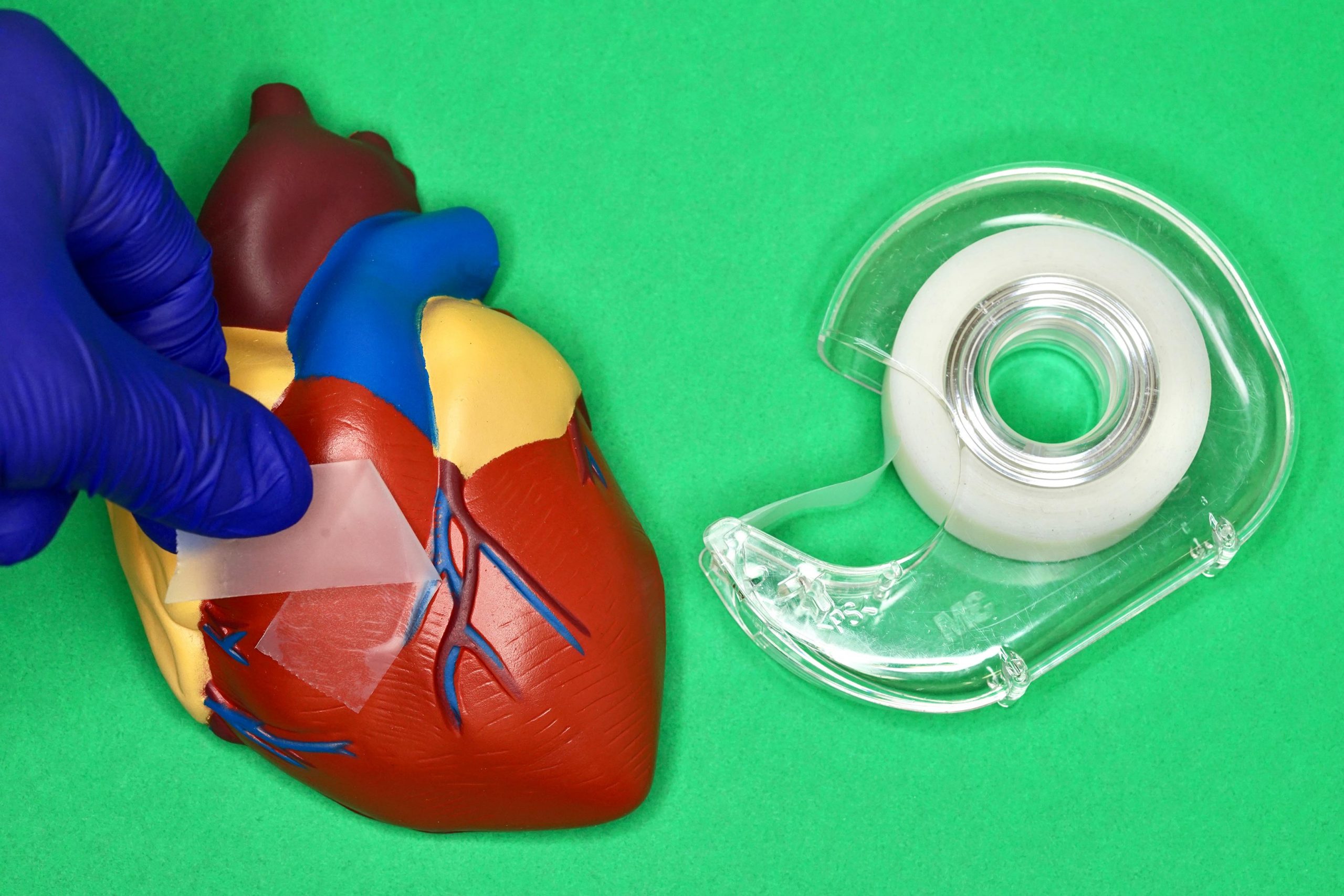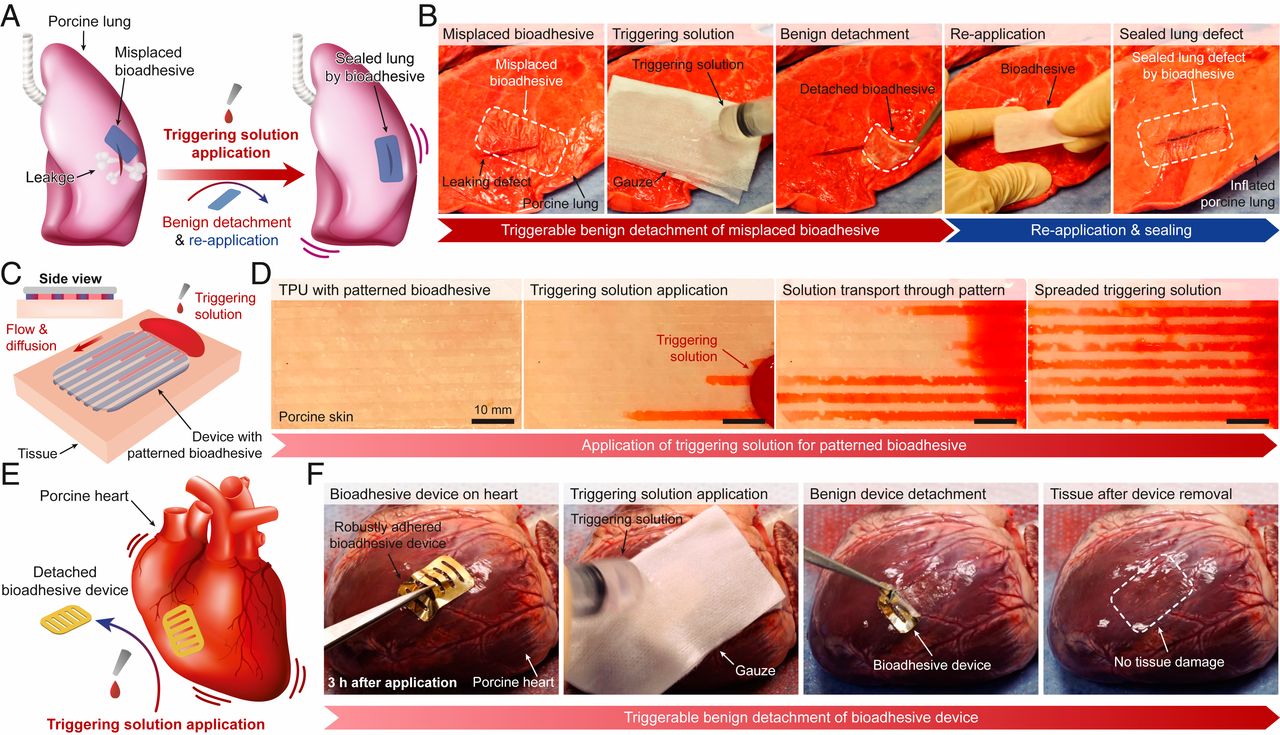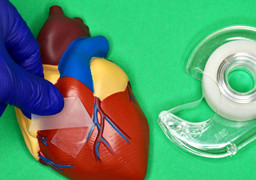м–ҙл–Ө мӢ кё°мҲ мқҙ м„ёмғҒмқ„ к·№м ҒмңјлЎң ліҖнҷ”мӢңнӮ¬к№Ң? м„ёкі„ мөңкі мқҳ м—°кө¬мҶҢм—җм„ң лӮҳмҳӨлҠ” лҶҖлқјмҡҙ нҳҒмӢ мқ„ лҸ…м җ мҶҢк°ңн•©лӢҲлӢӨ.

2019л…„, MIT м—”м§ҖлӢҲм–ҙл“Өмқҙ мғқл¬јн•ҷм Ғ мЎ°м§Ғкіј к°ҷмқҖ м –мқҖ н‘ңл©ҙм—җ л№ лҘҙкі лӢЁлӢЁн•ҳкІҢ л¶Җм°©н• мҲҳ мһҲлҠ” м–‘л©ҙ м ‘м°©м ңлҘј к°ңл°ңн–ҲлӢӨ. мқҙл“ӨмқҖ мқҙ м ‘м°©м ңлҘј мӮ¬мҡ©н•ҳм—¬ лӘҮ мҙҲ лӮҙм—җ нҸҗмҷҖ лӮҙмһҘмқҳ м°ўм–ҙм§җмқҙлӮҳ кө¬л©Қмқ„ л§үкұ°лӮҳ мӢ¬мһҘкіј к°ҷмқҖ мһҘкё°мқҳ н‘ңл©ҙм—җ мһ„н”ҢлһҖнҠё л°Ҹ кё°нғҖ мқҳлЈҢ кё°кё°лҘј л¶Җм°©н• мҲҳ мһҲмқҢмқ„ ліҙм—¬мӨ¬лӢӨ.
мӣҗлһҳ м ‘м°©м ңмқҳ л””мһҗмқёмқ„ кі л Өн•ҳл©ҙм„ң м—°кө¬мӣҗл“ӨмқҖ м –мқҖ н‘ңл©ҙм—җлҠ” м ‘м°©м ңлҘј л¶Җм°©н•ҳкё°к°Җ к·№лҸ„лЎң м–ҙл өкі , м ‘м°©мқҙ лҗңлӢӨ н•ҳлҚ”лқјлҸ„ м ‘м°©л Ҙ мң м§Җк°Җ лҗҳм§Җ м•ҠлҠ”лӢӨлҠ” м җмқ„ м•Ңм•ҳлӢӨ.
мЎ°м§Ғмқҳ мһҗм—°м Ғмқё лҜёлҒ„лҹ¬мӣҖмқ„ н•ҙкІ°н•ҳкё° мң„н•ҙ м—°кө¬мӣҗл“ӨмқҖ кё°м Җк·ҖмҷҖ мқҳм•Ҫн’Ҳм—җ мқјл°ҳм ҒмңјлЎң мӮ¬мҡ©лҗҳлҠ” нқЎмҲҳм„ұмқҙ лҶ’мқҖ л¬јм§Ҳмқё нҸҙлҰ¬ м•„нҒ¬лҰҙмӮ°мқ„ нҸ¬н•Ён•ң мғқмІҙ м Ғн•©м„ұ нҸҙлҰ¬лЁёлЎңл¶Җн„° кі мң мқҳ м ‘м°©л Ҙмқ„ м„Өкі„н•ҳмҳҖлӢӨ. мқҙлҹ¬н•ң кё°м Җк·ҖмҷҖ мқҳм•Ҫн’ҲмқҖ мҲҳ분мқ„ нқЎмҲҳн•ң нӣ„ мЎ°м§Ғ н‘ңл©ҙкіј м•Ҫн•ң мҲҳмҶҢ кІ°н•©мқ„ л№ лҘҙкІҢ нҳ•м„ұн•ңлӢӨ. мқҙлҹ¬н•ң кІ°н•©мқ„ к°•нҷ”н•ҳкё° мң„н•ҙ м—°кө¬нҢҖмқҖ н•ҙлӢ№ л¬јм§Ҳм—җ мЎ°м§Ғ н‘ңл©ҙмқҳ лӢЁл°ұм§Ҳкіј лҚ” к°•н•ҳкі мҳӨлһҳ м§ҖмҶҚлҗҳлҠ” кІ°н•©мқ„ нҳ•м„ұн•ҳлҠ” нҷ”н•ҷл¬ј NHS м—җмҠӨн…ҢлҘҙлҘј мІЁк°Җн–ҲлӢӨ.

мқҙлҹ¬н•ң нҷ”н•ҷм Ғ кІ°н•©мқҖ м ‘м°©м ңм—җ л§Өмҡ° к°•л Ҙн•ң м ‘м°© лҠҘл Ҙмқ„ мӨ¬лӢӨ. н•ҳм§Җл§Ң л–јм–ҙлӮҙкё°к°Җ м–ҙл Өмӣ лӢӨ. к·ёлҰ¬кі мЎ°м§Ғм—җм„ң м ‘м°©м ңлҘј л–јм–ҙлӮҙлҠ” мһ‘м—…мқҙ м§Җм Җ분н•ҳм—¬ мһ мһ¬м ҒмңјлЎң н•ҙлЎңмҡҙ мқјмһ„мқ„ м•ҢкІҢ лҗҳм—ҲлӢӨ.
м ‘м°©м ңлҘј м ңкұ°н•ҳл©ҙ мһ мһ¬м ҒмңјлЎң мЎ°м§Ғм—җ лҚ” л§ҺмқҖ м—јмҰқ л°ҳмқ‘мқ„ мқјмңјнӮӨкі м№ҳлЈҢм—җ лҚ” л§ҺмқҖ мӢңк°„мқҙ мҶҢмҡ”лҗ мҲҳ мһҲлӢӨ. мқҙлҠ” л§Өмҡ° нҳ„мӢӨм Ғмқё л¬ём ңмқҙлӢӨ.
к·ёлһҳм„ң м—°кө¬нҢҖмқҖ мЎ°м§Ғм—җ м–ҙл–Ө мҶҗмғҒлҸ„ мқјмңјнӮӨм§Җ м•Ҡкі кё°ліё мЎ°м§Ғм—җм„ң 분лҰ¬лҗ мҲҳ мһҲлҸ„лЎқ мһЎм°©м ңлҘј лҚ” м •м ңн•ҳлҠ” м—°кө¬м—җ м°©мҲҳн–ҲлӢӨ. мҲҳмҲ мӨ‘ мЎ°м •мқҙ н•„мҡ”н•ҳкұ°лӮҳ мЎ°м§Ғмқҙ м№ҳмң лҗң нӣ„ м ‘м°©м ңлҘј м ңкұ°н•ҙм•јн•ҳлҠ” кІҪмҡ°, мқҙл“Өмқҙ м—°кө¬н•ң мғҲлЎңмҡҙ лІ„м „мқҖ м•ЎмІҙ мҡ©м•Ўмқ„ лҸ„нҸ¬н•ң нӣ„ лҜёлҒ„лҹ¬мҡҙ м ӨмІҳлҹј лІ—кІЁлӮј мҲҳ мһҲм—ҲлӢӨ.
мқҙкІғмқҖ лӮҙл¶Җ мһҘкё°лҘј мң„н•ң нҶөмҰқм—ҶлҠ” л°ҳм°Ҫкі мҷҖ к°ҷлӢӨ. м ‘м°©м ңлҘј л°”лҘҙкі м–ҙл–Ө мқҙмң лЎңл“ лІ—кё°кі мӢ¶лӢӨл©ҙ н•„мҡ”м—җ л”°лқј нҶ мҰқмқ„ мң л°ңн•ҳм§Җ м•Ҡкі мқҙлҘј мҲҳн–үн• мҲҳ мһҲлӢӨ.

м—°кө¬нҢҖмқҳ мқҙ мғҲлЎңмҡҙ м—°кө¬лҠ” көӯлҰҪ кіјн•ҷ м•„м№ҙлҚ°лҜё нҡҢліҙ(the Proceedings of the National Academy of Sciences)м—җ кІҢмӢңлҗң л…јл¬ём—җ мһҗм„ёнһҲ м„ӨлӘ…лҗҳм–ҙ мһҲлӢӨ.
м ‘м°©м ңлҘј 분лҰ¬ н• мҲҳ мһҲлҸ„лЎқ нҢҖмқҖ лЁјм Җ м ‘м°© мһҗмІҙлҘј мЎ°м •н–ҲлӢӨ. мӣҗлһҳмқҳ л¬јм§Ҳм—җ мғҲлЎңмҡҙ мқҙнҷ©нҷ” л§Ғм»Ө 분мһҗлҘј 추к°Җн–ҲлҠ”лҚ°, мқҙлҠ” мЎ°м§Ғмқҳ н‘ңл©ҙ лӢЁл°ұм§Ҳкіј кіөмң кІ°н•© мӮ¬мқҙм—җ л°°м№ҳлҗ мҲҳ мһҲлӢӨ. м—°кө¬нҢҖмқҖ мқҙ нҠ№м • 분мһҗмқҳ кІ°н•©мқҙ к°•н•ҳм§Җл§Ң нҠ№м • нҷҳмӣҗм ңм—җ л…ём¶ңлҗҳл©ҙ мүҪкІҢ 분лҰ¬лҗ мҲҳ мһҲкё° л•Ңл¬ём—җ мқҙ нҠ№м • 분мһҗлҘј н•©м„ұн•ҳкё°лЎң кІ°м •н–ҲлӢӨ.
лӘЁл“ н…ҢмҠӨнҠём—җм„ң м ‘м°©м ңк°Җ мЎ°м§Ғм—җ м–јл§ҲлӮҳ мҳӨлһҳ лҸ„нҸ¬лҗҳм—ҲлҠ”м§Җм—җ кҙҖкі„м—Ҷмқҙ м—°кө¬мӣҗл“ӨмқҖ мқјлӢЁ нҠёлҰ¬кұ°л§Ғ мҡ©м•Ўмқ„ м ‘м°©м ңм—җ лҝҢл ёмқ„ л•Ң м•Ҫ 5분 мқҙлӮҙм—җ мЎ°м§Ғм—җм„ң м ‘м°©м ңлҘј лІ—кІЁлӮј мҲҳ мһҲлӢӨлҠ” кІғмқ„ л°ңкІ¬н–ҲлӢӨ. л¬јлЎ мЎ°м§Ғм—җлҠ” м–ҙл–Ө мҶҗмғҒлҸ„ мң л°ңн•ҳм§Җ м•Ҡм•ҳлӢӨ.
мҡ©м•Ўмқҙ н…Ңмқҙн”„лҘј нҶөн•ҙ н…Ңмқҙн”„к°Җ мЎ°м§Ғкіј л§ҢлӮҳлҠ” н‘ңл©ҙмңјлЎң нҷ•мӮ°лҗҳлҠ” лҚ° кұёлҰ¬лҠ” мӢңк°„мқҙ м§ҖлӮҳл©ҙ, к·ё мӢңм җл¶Җн„° мҡ©м•ЎмқҖ мқҙ к·№лҸ„лЎң лҒҲм ҒлҒҲм Ғн•ң м ‘м°©м ңлҘј мүҪкІҢ лІ—кІЁ лӮј мҲҳ мһҲлҠ” лҜёлҒ„лҹ¬мҡҙ м Ө мёөмңјлЎң ліҖнҷҳлҗңлӢӨ.
м—°кө¬нҢҖмқҖ м–ём к°Җ мҲҳмҲ мӢӨм—җ нҠёлҰ¬кұ°л§Ғ мҶ”лЈЁм…ҳ мһҘм№ҳмҷҖ н•Ёк»ҳ мқҙлҹ¬н•ң м ‘м°©м ң м ңкұ°кё°к°Җ м„Өм№ҳлҗҳкё°лҘј нқ¬л§қн•ңлӢӨ. к·ёлҹ° лӢӨмқҢ мҷёкіјмқҳлҠ” мқҙкІғмқ„ мҠӨм№ҙм№ҳн…Ңмқҙн”„мҷҖ к°ҷмқҙ мӮ¬мҡ©н•ҳм—¬ н•„мҡ”м—җ л”°лқј л¶Җм°© л°Ҹ 분лҰ¬, к·ёлҰ¬кі мһ¬л¶Җм°©мқ„ мһҗмң мһҗмһ¬лЎң н• мҲҳ мһҲмқ„ кІғмқҙлӢӨ.
- Proceedings of the National Academy of Sciences, June 23, 2020, вҖңInstant Tough Bioadhesive with Triggerable Benign Detachment,вҖқ by Xiaoyu Chen, et al. © 2020 National Academy of Sciences. All rights reserved
- To view or purchase this article, please visit:
https://www.pnas.org/content/117/27/15497
What new technologies will dramatically transform your world? WeвҖҷll present an exclusive preview of the stunning breakthroughs emerging from the worldвҖҷs leading research labs.
**
In 2019, MIT engineers developed a double-sided adhesive that can quickly and firmly stick to wet surfaces such as biological tissues. They showed that the tape could be used to seal up rips and tears in the lungs and intestines within seconds or to affix implants and other medical devices to the surfaces of organs such as the heart.
In considering designs for their original adhesive, the researchers quickly realized that it is extremely difficult for tape to stick to wet surfaces, as the thin layer of water lubricates and prevents most adhesives from taking hold.
To get around a tissueвҖҷs natural slipperiness, the team designed their original adhesive out of biocompatible polymers including polyacrylic acid, a highly absorbent material commonly used in diapers and pharmaceuticals that soaks up water, then quickly forms weak hydrogen bonds with the tissueвҖҷs surface. To reinforce these bonds, the researchers embedded the material with NHS esters, chemical groups that form stronger, longer-lasting bonds with proteins on a tissueвҖҷs surface.
While these chemical bonds gave the tape its ultra-strong grip, they were also difficult to break, and the team found that detaching the tape from tissue was a messy, potentially harmful task.
Removing the tape could potentially create more of an inflammatory response in tissue and prolong healing. ItвҖҷs a very practical problem.
Now they have further refined the adhesive so that it can be detached from the underlying tissue without causing any damage. In case it needs to be adjusted during surgery or removed once the tissue has healed, the new version can be peeled away like a slippery gel, after applying a liquid solution.
ItвҖҷs like a painless Band-Aid for internal organs. You put the adhesive on, and if for any reason you want to take it off, you can do so on-demand, without pain.
The teamвҖҷs new design is detailed in a paper just published in the Proceedings of the National Academy of Sciences.
To make the adhesive detachable, the team first tweaked the adhesive itself. To the original material, they added a new disulfide linker molecule, which can be placed between covalent bonds with a tissueвҖҷs surface proteins. The team chose to synthesize this particular molecule because its bonds, while strong, can be easily severed if exposed to a particular reducing agent.
In all their tests, regardless of how long the adhesive had been applied to the tissue, the researchers found that, once they sprayed the triggering solution onto the tape, they were able to peel the tape away from the tissue within about five minutes, without causing tissue damage.
ThatвҖҷs about the time it takes for the solution to diffuse through the tape to the surface where the tape meets the tissue. At that point, the solution converts this extremely sticky adhesive to just a layer of slippery gel that you can easily peel off.
The team hopes that someday, operating rooms can have dispensers of these adhesives, alongside bottles of triggering solution. Then, surgeons can use this like Scotch tape, applying, detaching, and reapplying it on demand.
References
Proceedings of the National Academy of Sciences, June 23, 2020, вҖңInstant Tough Bioadhesive with Triggerable Benign Detachment,вҖқ by Xiaoyu Chen, et al. © 2020 National Academy of Sciences. All rights reserved
To view or purchase this article, please visit:
https://www.pnas.org/content/117/27/15497










